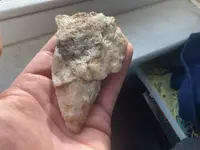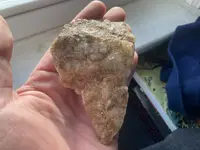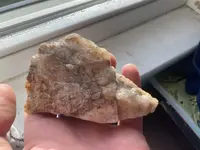You are using an out of date browser. It may not display this or other websites correctly.
You should upgrade or use an alternative browser.
You should upgrade or use an alternative browser.
Vague tool forms
- Thread starter Fred250
- Start date
Up-North
Hero Member
- Joined
- Nov 13, 2020
- Messages
- 571
- Reaction score
- 3,264
- Golden Thread
- 0
- Location
- s.e. Minnesota’s driftless area
- Primary Interest:
- All Treasure Hunting
Chill pill.... dude.
I saw your comment, keep on the hunt.
When you find a artifact you will know it.
No question about it.....
I saw your comment, keep on the hunt.
When you find a artifact you will know it.
No question about it.....
Tesorodeoro
Bronze Member
- Joined
- Jan 21, 2018
- Messages
- 1,977
- Reaction score
- 3,230
- Golden Thread
- 0
- Primary Interest:
- All Treasure Hunting
Fred250
Hero Member
- Joined
- Jun 30, 2018
- Messages
- 541
- Reaction score
- 465
- Golden Thread
- 0
- Primary Interest:
- All Treasure Hunting
- #44
Thread Owner
All artifacts IMO and I’d take them to U or anyone in the area to judge in person but will likely never happen. Don’t want to get pro’s involved as not my property. Thanks for the opinions. Don’t want to hurl insults around so I apologize to those I did it too.
Fred250
Hero Member
- Joined
- Jun 30, 2018
- Messages
- 541
- Reaction score
- 465
- Golden Thread
- 0
- Primary Interest:
- All Treasure Hunting
- #45
Thread Owner
I wasn’t kidding, you should stay on arrowheads.comChill pill.... dude.
I saw your comment, keep on the hunt.
When you find a artifact you will know it.
No question about it.....
Last edited by a moderator:
Fred250
Hero Member
- Joined
- Jun 30, 2018
- Messages
- 541
- Reaction score
- 465
- Golden Thread
- 0
- Primary Interest:
- All Treasure Hunting
- #46
Thread Owner
Good one, I’m over it if you are. I hope we can agree to disagree as your knowledge of what I’m talking about is limited, but so is mine. If not I like to fight but I will likely be banned. I don’t think we need to go there, I see you point of view even though it is totally flawed. I hope we can argue for fun and learning and not for pointless pride. I would
Love to show this stuff to someone with experience in person if anyone in the MA area is up for it, let
Me know.
Love to show this stuff to someone with experience in person if anyone in the MA area is up for it, let
Me know.
uniface
Silver Member
- Joined
- Jun 4, 2009
- Messages
- 3,216
- Reaction score
- 2,905
- Golden Thread
- 0
- Location
- Central Pennsylvania
- Primary Interest:
- Other
And you should find a new hobby... rock boy
Suggest you (and Indian Steve) not only read, but study the Pleistocene Coalition articles linked-to in the "the break" thread. With particular attention to the (via screen enlarge) artifact pictures.
Indian Steve
Silver Member
You can uproot any tree on my property and find dozens of ROCKS like yours in the roots.
uniface
Silver Member
- Joined
- Jun 4, 2009
- Messages
- 3,216
- Reaction score
- 2,905
- Golden Thread
- 0
- Location
- Central Pennsylvania
- Primary Interest:
- Other
For whatever it may be worth, Fred sent me a box containing maybe 40 examples of what are being written off as "just rocks." It took me about 10 seconds to recognise them as obvious tools, expertly and ingeniously made from really unpromising material that, given the New England setting, must have been the best available there.
Last edited:
Fred250
Hero Member
- Joined
- Jun 30, 2018
- Messages
- 541
- Reaction score
- 465
- Golden Thread
- 0
- Primary Interest:
- All Treasure Hunting
- #51
Thread Owner
Thanks you didn’t have to do that, really just needed to know for my own peace of mind. Working on dry January, had a rough New Years Day morning.
Last edited:
southfork
Silver Member
- Joined
- Jun 15, 2014
- Messages
- 2,522
- Reaction score
- 8,299
- Golden Thread
- 0
- Location
- California
- Primary Interest:
- All Treasure Hunting
For whatever it may be worth, Fred sent me a box containing maybe 40 examples of what are being written off as "just rocks." It took me about 10 seconds to recognise them as obvious tools, expertly and ingeniously made from really unpromising material that, given the New England setting, must have been the best available there.
I see a few pieces that could be tools ? but being able to I. D. 40 examples in 10 seconds is amazing .
uniface
Silver Member
- Joined
- Jun 4, 2009
- Messages
- 3,216
- Reaction score
- 2,905
- Golden Thread
- 0
- Location
- Central Pennsylvania
- Primary Interest:
- Other
being able to I. D. 40 examples in 10 seconds is amazing
Sounds (looks) that way on paper (screen). But when you keep finding that they're unifaces with straight lower edges @ various angles (cutting & scraping), it dawns on you that there's nothing random about them. The intent underlying them comes across unambiguously. This quality is easier to recognise (familiarity) with material high enough in quality to allow edge shaping by retouching, but usable edges with the excess knocked out of the way works just as well.
Example (not Fred's) :
https://tse2.mm.bing.net/th?id=OIP.hXolY6ETqtItJ82IAmk9CwHaFj&pid=Api&P=0&w=248&h=186
Maybe when Fred gets them back he will care to illustrate this.
Last edited:
dognose
Silver Member
It's reasonable to believe that different styles of relics and materials are found in different regions.
When I lived outside in Jefferson County Missouri, finding Native American relics was different than finding them in where I am in Indiana. Likewise the material utilized are different, just not for different culture periods, but across the board. Sure I find Burlington flint in Indiana, and I found Harrison County flint in the Ozark foothills, but not in the same quantity.
I can't tell for sure from photographs if a stone has almost microscopic flaking. Likewise I would question whether anyone could tell if an item is authentic without question from a photo.
I suspect that early cultures may have utilized rough stone flakes, spalls and objects more so than a more highly organized and learned culture. If so these may have been earlier than Clovis culture. One would have to then believe on material this old, weathering, erosion, exfoliation and breakdown could result in a false positive sort on an item. Where a rock appears to have indications indicative of a used relic tool.
It could also lean the other way and give a false negative on what would be an authentic relic - where a true relic is thought to be simply a rock.
Many look for an obvious stone flaked or pecked stone tool, while others specialize in what they may find more of - the older somewhat rougher tools.
Beauty is in the eye of the beholder. Good thing as I am one gnarly dude and my wife still loves me.
Likewise collectability and desirability is also in the eye of the beholder.
Look harder, as likely there are other more finely made native American tools and relics in the area, but don't discount what your finding a simply nothing without close inspection under magnification.
When I lived outside in Jefferson County Missouri, finding Native American relics was different than finding them in where I am in Indiana. Likewise the material utilized are different, just not for different culture periods, but across the board. Sure I find Burlington flint in Indiana, and I found Harrison County flint in the Ozark foothills, but not in the same quantity.
I can't tell for sure from photographs if a stone has almost microscopic flaking. Likewise I would question whether anyone could tell if an item is authentic without question from a photo.
I suspect that early cultures may have utilized rough stone flakes, spalls and objects more so than a more highly organized and learned culture. If so these may have been earlier than Clovis culture. One would have to then believe on material this old, weathering, erosion, exfoliation and breakdown could result in a false positive sort on an item. Where a rock appears to have indications indicative of a used relic tool.
It could also lean the other way and give a false negative on what would be an authentic relic - where a true relic is thought to be simply a rock.
Many look for an obvious stone flaked or pecked stone tool, while others specialize in what they may find more of - the older somewhat rougher tools.
Beauty is in the eye of the beholder. Good thing as I am one gnarly dude and my wife still loves me.
Likewise collectability and desirability is also in the eye of the beholder.
Look harder, as likely there are other more finely made native American tools and relics in the area, but don't discount what your finding a simply nothing without close inspection under magnification.
nunyabiz111
Full Member
- Joined
- Jun 15, 2018
- Messages
- 128
- Reaction score
- 128
- Golden Thread
- 0
- Primary Interest:
- All Treasure Hunting
It's reasonable to believe that different styles of relics and materials are found in different regions.
would just like to comment with a friendly and unpartisan (deleted by mod for rule infraction) to any/all notions behind that one single statement as quoted
Last edited by a moderator:
Fred250
Hero Member
- Joined
- Jun 30, 2018
- Messages
- 541
- Reaction score
- 465
- Golden Thread
- 0
- Primary Interest:
- All Treasure Hunting
- #59
Thread Owner
Thanks those are the fine ones on that site surprisingly enough. I know right where to find them, left more than I took. No one else will ever find them, or recognize them for what they are if they did. I figured maybe someday someone will want to take a look, but I doubt it. I get back there maybe once or twice every couple years, but if I get corona’d I’m pretty sure they’ll be there for a few thousand more years.
uniface
Silver Member
- Joined
- Jun 4, 2009
- Messages
- 3,216
- Reaction score
- 2,905
- Golden Thread
- 0
- Location
- Central Pennsylvania
- Primary Interest:
- Other
In evaluating them you have to take into account how coarse the texture of that stuff is. Cross between quartzite and conglomerate with bits of quartz. I'm impressed they did as well with it as they did -- not to make pretty shapes but sharp, usable edges.
FWIW
FWIW
Similar threads
- Replies
- 2
- Views
- 442
- Replies
- 25
- Views
- 1K
Users who are viewing this thread
Total: 1 (members: 0, guests: 1)





